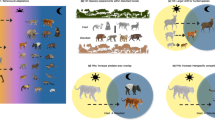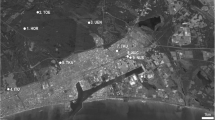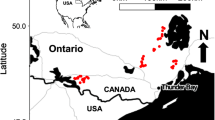Abstract
Interspecific foraging associations are well-documented phenomena, characterized by one or more species exploiting the behavior of another species to decrease predation or increase foraging success. In rare cases, birds directly exploit human behavior, but examples of these interactions are limited to species that naturally occur in edge, open, or disturbed habitats. With observations and experiments we provide evidence of insectivorous birds exploiting human disturbance in primary subalpine forest in the mountains of southern China, displaying behavioral flexibility to gain novel foraging opportunities. We cut and cleared small swaths of dense bamboo growth for an unrelated study. Multiple insectivorous species were recruited to the cleared areas, foraging extensively in the disturbed earth, often within 1 m of us. These species included Tarsiger chrysaeus, Tarsiger indicus, Cettia brunnifrons or Cettia major, and Heteroxenicus stellatus. This behavior is likely a modification of pre-existing interspecific foraging associations with pheasants and large mammals in the region. These larger animals disturb the earth and lower vegetation layers upon passage and while foraging, exposing previously inaccessible invertebrate prey items on which small insectivorous birds can feed. Our findings highlight a behavioral capacity in birds to utilize human disturbance in an ecosystem with limited human presence.
Zusammenfassung
Menschlicher Einfluss liefert Vögeln im subalpinen Primärwald eine Gelegenheit zur Nahrungssuche
Beziehungen zwischen Arten bei der Nahrungssuche sind gut dokumentierte Phänomene, welche dadurch gekennzeichnet sind, dass eine oder mehrere Arten das Verhalten einer anderen Art nutzen, um ihr Prädationsrisiko zu verringern oder den Erfolg bei der Nahrungssuche zu erhöhen. In seltenen Fällen nutzen Vögel menschliches Verhalten direkt, allerdings sind Beispiele solcher Interaktionen auf Arten beschränkt, die natürlicherweise in Randhabitaten oder in offenen oder Ruderallebensräumen vorkommen. Durch Beobachtungen und Experimente liefern wir Belege dafür, wie insektenfressende Vögel menschliche Einflussnahme im subalpinen Primärwald in den Bergen Südchinas nutzen und dabei eine Verhaltensflexibilität zeigen, welche es ihnen ermöglicht, neue Futterquellen aufzutun. Für eine unabhängige Untersuchung mähten wir schmale Streifen dichter Bambusbestände und entfernten das Mähgut. Eine Vielzahl insektenfressender Arten wurde von den gerodeten Flächen angezogen und suchte im aufgebrochenen Erdboden nach Nahrung, oft weniger als einen Meter von uns entfernt. Zu diesen Arten gehörten: Tarsiger chrysaeus, T. indicus, Cettia brunnifrons oder C. major sowie Heteroxenicus stellatus. Diese Verhaltensweise stellt wahrscheinlich eine Modifikation bereits existierender interspezifischer Beziehungen bei der Nahrungssuche zu Fasanen und Großsäugern in der Region dar. Diese größeren Tiere bringen beim Vorbeilaufen und auf der Futtersuche den Erdboden und die unteren Vegetationsschichten durcheinander und fördern dabei zuvor unzugängliche wirbellose Beutetiere zutage, von welchen sich kleine insektivore Vögel ernähren können. Unsere Befunde zeigen bei Vögeln ein Verhaltenspotenzial zur Nutzung menschlicher Einflussnahme in einem Ökosystem mit eingeschränkter menschlicher Präsenz auf.



Similar content being viewed by others
References
Beasley LE, Carothers SW (1974) Unusual feeding habits in two species of blackbirds. Wilson Bull 86:478–479
Beiseigel BM (2007) Foraging association between Coatis (Nasua nasua) and Birds of the Atlantic Forest, Brazil. Biotropica 39:283–285
Buffon G (1771–1783) Histoire naturelle des oiseaux. Imprimerie royale, Paris
Dean WRJ, MacDonald IAW (1981) A review of African birds feeding in association with mammals. Ostrich 52:135–155
del Hoyo J, Elliott A, Christie D (2005) Handbook of the birds of the world. Lynx, Barcelona
Dugatkin LA (2013) Principles of animal behavior. Norton, New York
Fjeldså JR, Bowie C, Rahbek C (2012) The role of mountain ranges in the diversification of birds. Annu Rev Ecol Evol Syst 43:249–265
Heymann EW, Hsia SS (2015) Unlike fellows—a review of primate-non-primate associations. Biol Rev 90:142–156
Johnson KG, Schaller GB, Jinchu H (1988) Comparative behavior of Red and Giant Pandas in the Wolong Reserve, China. J Mammol 69:552–564
King AJ, Cowlishaw G (2008) Foraging opportunities drive interspecific associations between Rock Kestrels and Desert Baboons. J Zool 277:111–118
Kuniy AA, de Morais Jr MM, Gomes EPC (2003) Association between Olivaceous Woodcreeper (Sittasomus griseicapillus) and Golden Lion Tamarin (Leontopithecus rosalia) at Uniao Biological Reserve, Rio das Ostras, Brazil. Acta Biol Leopoldensia 25:261–264
Lack D (1948) Notes on the ecology of the robin. Ibis 90:252–279
Loucks CJ, Lu Z, Dinerstein E, Wang H, Olson DM, Zhu C, Wang D (2001) Giant pandas in a changing landscape. Science 294:1465
Rand AL (1953) Factors affecting feeding rates of anis. Auk 70:26–30
Sheldon WG (1937) Notes on the Giant Panda. J Mammal 18:13–19
Walther G, Post E, Convey P, Menzel A, Parmesan C, Beebee T, Fromentin J, Hoegh-Guldberg O, Bairlein F (2002) Ecological responses to recent climate change. Nature 416:389–395
Willis EO, Oniki Y (1978) Birds and Army Ants. Annu Rev Ecol Evol Syst 9:243–263
Wu Y, DuBay SG, Colwell RK, Ran J, Lei F (2016) Mobile hotspots and refugia of avian diversity in the mountains of south-west China under past and contemporary global climate change. J Biogeogr. doi:10.1111/jbi/12862
Zhang S, Wang L (2000) Following of Brown Capuchin Monkeys by White Hawks in French Guiana. Condor 102:198–201
Zhou HM, Li YD, Jiang Y, Yuan YL, Zhou ZR, Yang CM, Deng MJ, Shao FL, Wu M, Wang SP, Li Y, Wei CY, Qin H, Zhang H, Huang F, Yu GB, Li ZM, He LY, Yang Y, Chen XW, Zhao CQ, Shi L, Li LL, Li L (2014) Birds of Gonggashan Reserve. University of Electronic Sciences and Technology of China Press, Chengdu
Acknowledgements
This study would not have been possible without the help and support of the staff of Gongga Shan National Nature Reserve and Hailuoguo Forestry Bureau, specifically Zhou Huaming, Li Yugang, Mao Shaojun, Xie Qiang, and Ni Tianzhen. We thank Liu Qiao at the Institute of Mountain Hazards and Environment, Chinese Academy of Science for supplying the climate data. This work was funded by grants to S. G. D. from the National Geographic Society/Waitt Fund, the American Philosophical Society, the American Museum of Natural History, the American Ornithologists’ Union, the Society for the Study of Evolution, the Paulson Institute, and the Animal Behavior Society, and by grants to Y. W. from the National Natural Science Foundation of China (no. 31501851) and the International Visiting Program for Excellent Young Scholars of Sichuan University. A. H. R. acknowledges the Danish National Research Foundation for support to the Center for Macroecology, Evolution and Climate. We thank Daniela H. Palmer, Trevor D. Price, Alex E. White, and two anonymous reviewers for their thoughtful comments on previous versions of this manuscript. The experiments in this study comply with the current laws of the country in which they were performed.
Author information
Authors and Affiliations
Corresponding author
Additional information
Communicated by O. Krüger.
Electronic supplementary material
Below is the link to the electronic supplementary material.
Appendix: a video showing a female-plumaged White-browed Bush-robin (Tarsiger indicus) foraging in a recently cleared net lane (MOV 64318 kb)
Rights and permissions
About this article
Cite this article
DuBay, S.G., Reeve, A.H. & Wu, Y. Human disturbance provides foraging opportunities for birds in primary subalpine forest. J Ornithol 158, 833–839 (2017). https://doi.org/10.1007/s10336-017-1442-y
Received:
Revised:
Accepted:
Published:
Issue Date:
DOI: https://doi.org/10.1007/s10336-017-1442-y




